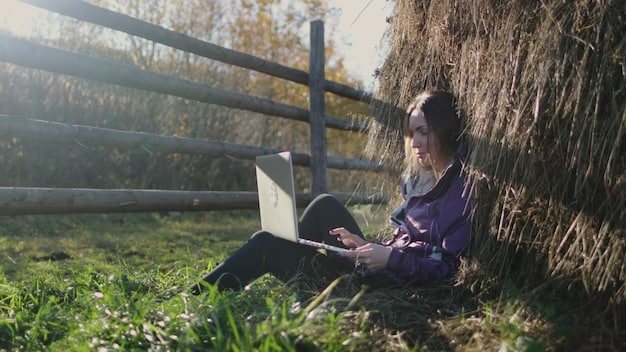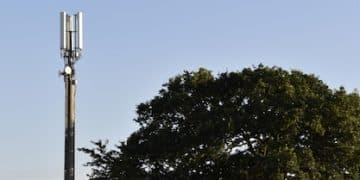SpaceX Starlink: 99% US Coverage by End of 2025?

SpaceX’s Starlink aims to achieve 99% coverage in the US by the end of 2025, expanding its satellite internet service to reach nearly every corner of the nation, promising faster speeds and lower latency for users in underserved areas.
The buzz around SpaceX’s Starlink update: Achieving 99% coverage in the US by end of 2025? is growing louder as the company ramps up its efforts to blanket the nation with high-speed internet. But many are now asking themselves is if this launch is another Elon Musk over promise, or finally the end of horrible rural internet.
Starlink’s Ambitious Goal: 99% Coverage
SpaceX’s Starlink has declared its plan to achieve 99% coverage in the United States by the end of 2025. This ambitious objective highlights Starlink’s intent to revolutionize internet access, particularly in rural and underserved regions. The question is no longer if they intend to hit this goal, but can Starlink really achieve this ambitious milestone?
This level of coverage would essentially mean near-ubiquitous availability of Starlink’s satellite internet service across the US. This could bridge the digital divide and offer high-speed, low-latency internet to people who previously had limited or no access.
Current Starlink Coverage and Expansion
As of late 2024, Starlink’s coverage in the US is significant, but not yet at the ambitious 99% target. The company has been actively launching more satellites and expanding its ground infrastructure to improve service availability. However, achieving near-total coverage presents substantial logistical and technological challenges.
The current infrastructure already delivers the kind of speed that most people don’t belive is possible. This is thanks to the use of cutting edge tech from SpaceX and their ability to quickly adapt and change the technology.
- Satellite Launches: SpaceX continues to launch batches of Starlink satellites regularly, increasing the constellation’s size and capabilities.
- Ground Stations: Building and maintaining ground stations across the US is critical for data transfer and service provision.
- User Terminals: The availability and affordability of user terminals (the hardware needed to access the service) play a key role in adoption rates.
Reaching 99% coverage requires addressing various challenges, including regulatory hurdles, geographic limitations, and competition from other internet providers. Despite these obstacles, SpaceX remains committed to its goal and continues to innovate to overcome these challenges.

Challenges in Achieving Complete Coverage
While the vision of 99% coverage is exciting, it is essential to acknowledge the hurdles that Starlink must overcome to realize this goal. These challenges span technological, financial, and regulatory domains, each presenting a unique set of obstacles that need to be addressed.
One of the most immediate challenges is the uneven population distribution across the US. Achieving 99% coverage would mean ensuring service availability in sparsely populated rural areas, which may require significant investments in infrastructure with limited return.
Technological Hurdles
Advancing satellite technology is vital to enhancing Starlink’s capabilities. This includes improving satellite lifespan, increasing bandwidth, and reducing latency. Overcoming technical limitations is key to delivering a consistent and high-quality service across the country.
Each new launch of satellites is another opportunity to refine and improve the orbital tech. This happens with every company involved in space, but SpaceX has turned this kind of refinement into a competitive advantage.
Financial and Logistical Barriers
Deploying and maintaining a vast network of satellites and ground stations need substantial financial backing. Managing the logistics of delivering user terminals to remote areas adds another layer of complexity. Affordability is another challenge, especially for low-income households.
- Infrastructure Costs: The expenses associated with satellite launches, ground station construction, and maintenance are considerable.
- User Terminal Costs: The initial cost of the user terminal can be a barrier for many potential customers.
- Operational Expenses: Ongoing costs include satellite maintenance, software updates, and customer support.
Addressing these challenges will be crucial for Starlink to achieve its ambitious goal of 99% coverage and provide reliable internet access to all Americans.
Competition in the Satellite Internet Market
Starlink is not the only player in the satellite internet market. Several other companies are competing to provide satellite-based internet services, each with its own strengths and strategies. Understanding the competitive landscape is vital for assessing Starlink’s prospects and potential market share.
Companies like Viasat and HughesNet have been around for a long time, providing satellite internet services to customers across the U.S. These players are working to improve their offerings and remain competitive in the market.
Key Competitors and Their Strategies
Viasat and HughesNet are traditional satellite internet providers with established customer bases. Amazon’s Project Kuiper is an emerging contender with plans to launch its own satellite constellation. Each competitor has a unique approach to delivering internet access.
These larger companies have deep links with other telecommunications companies. So while a start-up like Starlink would have seemed dead on arrival ten years ago, they are now threatening the status quo.
Starlink’s Competitive Advantages
Starlink’s main advantage lies in its use of low Earth orbit (LEO) satellites, which offer lower latency and higher speeds compared to traditional geostationary satellites. SpaceX’s expertise in rocket technology also gives Starlink a cost advantage in launching and deploying satellites.
- Low Latency: LEO satellites significantly reduce latency, making Starlink more suitable for real-time applications like video conferencing and gaming.
- High Speeds: Starlink aims to deliver download speeds comparable to terrestrial broadband services.
- Scalability: The ability to launch satellites frequently allows Starlink to quickly expand its network and increase capacity.
To maintain its competitive edge, Starlink must continue to innovate and enhance its technology. By focusing on improving service quality and expanding coverage, Starlink can solidify its position in the satellite internet market.
Impact on Rural Communities
One of the most significant potential benefits of Starlink achieving 99% coverage is its transformative impact on rural communities. These areas often lack access to reliable high-speed broadband, which can hinder economic development, education, and healthcare.
Access to high-speed internet can boost economic opportunities in rural areas, allowing businesses to thrive and attract new investments. Education can also benefit from improved internet access, enabling students to access online learning resources and participate in remote classes.
Economic Development
Reliable internet access can support remote work, e-commerce, and other business activities. This can create jobs and stimulate economic growth in rural communities. Improved connectivity can also attract new residents and businesses to these areas.
One of the biggest concerns of rural industry is attracting talent. But with reliable high-speed internet, these local rural operations can have access to the same experts and tech wizards as businesses in population dense cities.
Education and Healthcare
Having broadband is essential for online learning, research, and collaboration. Telemedicine and remote health monitoring can improve healthcare access and outcomes in rural areas.
- Online Education: Students can access a wealth of educational resources and participate in online courses regardless of their location.
- Telemedicine: Remote consultations and monitoring can improve healthcare access for residents in rural areas.
- Community Engagement: Increased connectivity can foster community engagement and social interaction.
Achieving 99% coverage can enable rural communities to participate fully in the digital economy and improve their quality of life. This could lead to a revitalization of these areas and reduce the gap between urban and rural opportunities.

The Future of Starlink Beyond 2025
Looking beyond 2025, Starlink has the potential to evolve further and expand its services. The company is exploring new technologies and applications that could shape the future of satellite internet. Continuous innovation will be key to sustaining Starlink’s growth and relevance.
This is all possible thanks to the ability of SpaceX to vertically integrate all tech and labor. Being able to build everything in-house is why SpaceX has been able to dominate the space industry.
Potential Future Developments
Future developments may include increased satellite capabilities, reduced latency, improved user terminals, and new service offerings. Starlink is also exploring partnerships with other companies to expand its reach and integrate its services with other technologies.
The company has also been looking to serve a wider international market. There are many places across the globe that can benefit from Starlink’s offerings.
New Technologies and Applications
Starlink could integrate its services with IoT (Internet of Things) devices, enabling connectivity for remote sensors, smart devices, and other applications. The company may also explore using its satellite network for emergency communications and disaster relief.
- IoT Connectivity: Connecting remote devices and sensors for environmental monitoring, agriculture, and other applications.
- Emergency Communications: Providing critical communication infrastructure during natural disasters and emergencies.
- Global Expansion: Extending Starlink’s services to other countries and regions around the world.
As Starlink continues to innovate and expand its capabilities, it is poised to play a significant role in the future of global internet connectivity. Its success in achieving near-ubiquitous coverage in the US can serve as a model for other countries and regions striving to bridge the digital divide.
How to Get Starlink in Your Area
The process of obtaining Starlink service involves several steps, starting with checking availability in your area and ordering the necessary equipment. Understanding the installation process and optimizing your setup can ensure a smooth experience.
Check their official website to find the most information on their products. It’s always a good idea to order your products online to keep track of any sales or deals.
Checking Availability and Ordering
Visit the Starlink website and enter your address to check if the service is available in your area. If available, follow the instructions to place an order for the Starlink Kit, which includes the user terminal and necessary cables.
When placing your order, make sure to fully understand all the terms of service as well as the requirements. This will help avoid any unwanted problems with the service later.
Installation and Setup
The Starlink Kit includes instructions for self-installation. Choose a location with a clear view of the sky and follow the steps to mount and connect the user terminal. The Starlink app can help you find an optimal location for the dish.
- Clear Sky View: Ensure the user terminal has an unobstructed view of the sky for optimal performance.
- Power and Connectivity: Connect the user terminal to a power source and your home network.
- Software Updates: Regularly update the Starlink software to ensure you have the latest features and improvements.
By following these steps, you can successfully set up Starlink and enjoy high-speed internet in your area. The key is to ensure a clear sky view and follow the instructions provided by Starlink for a hassle-free installation process.
| Key Point | Brief Description |
|---|---|
| 🚀 99% Coverage Goal | Starlink aims for near-ubiquitous US coverage by 2025, focusing on rural areas. |
| 🛰️ LEO Satellites | Low Earth Orbit satellites offer lower latency and higher speeds. |
| 💸 Economic Impact | Improves rural economies, education, and healthcare through connectivity. |
| 📶 Competitors | Faces competition from Viasat, HughesNet, and Amazon’s Project Kuiper. |
Frequently Asked Questions
▼
Starlink aims to achieve 99% coverage across the United States by the end of 2025, focusing particularly on providing internet access to underserved rural areas.
▼
Starlink uses a constellation of low Earth orbit (LEO) satellites to deliver high-speed, low-latency internet to users on the ground via a user terminal.
▼
The main challenges include technological hurdles, financial and logistical barriers, regulatory approvals, and competition from other satellite internet providers.
▼
Starlink provides high-speed internet access, which can boost economic development, enhance education through online learning, and improve healthcare through telemedicine in rural areas.
▼
You can check availability on the Starlink website by entering your address. If available, you can order the Starlink Kit and follow the installation instructions provided.
Conclusion
In conclusion, SpaceX’s Starlink’s update: Achieving 99% coverage in the US by end of 2025? is an ambitious project with the goal to revolutionize internet accessibility across the United States. While challenges remain, the potential impact on rural communities and the overall digital landscape is significant, marking a pivotal moment in the evolution of internet connectivity.





